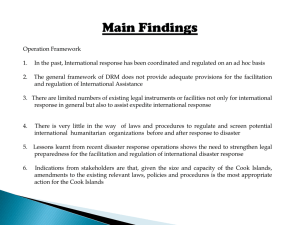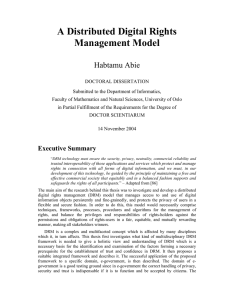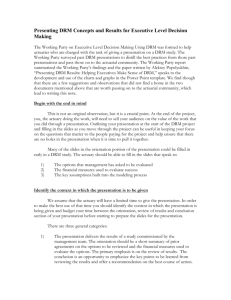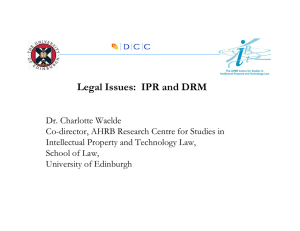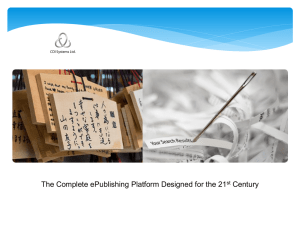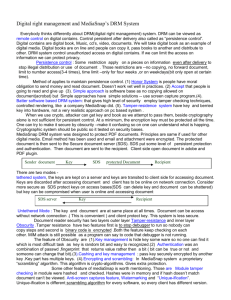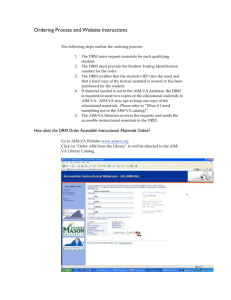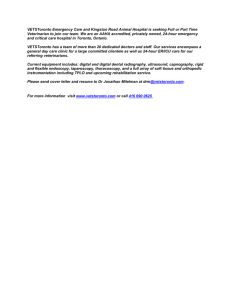New Productivity Initiative WG D. Pulsipher Architectural Area
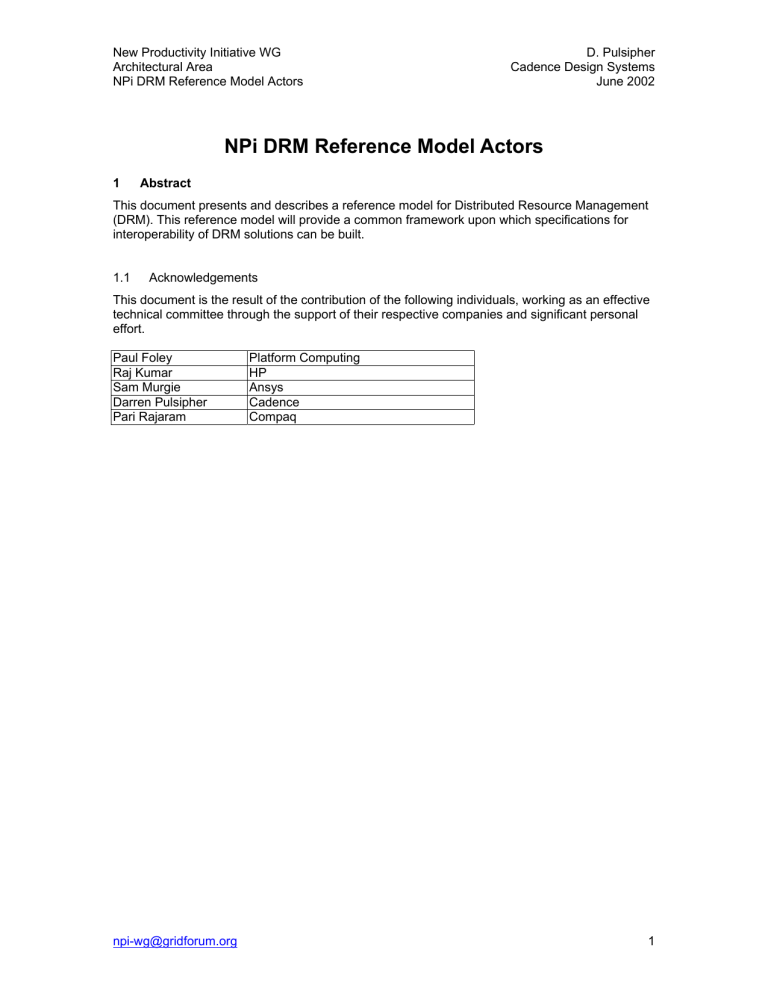
New Productivity Initiative WG
Architectural Area
NPi DRM Reference Model Actors
D. Pulsipher
Cadence Design Systems
June 2002
NPi DRM Reference Model Actors
1 Abstract
This document presents and describes a reference model for Distributed Resource Management
(DRM). This reference model will provide a common framework upon which specifications for interoperability of DRM solutions can be built.
1.1 Acknowledgements
This document is the result of the contribution of the following individuals, working as an effective technical committee through the support of their respective companies and significant personal effort.
Paul Foley
Raj Kumar
Sam Murgie
Darren Pulsipher
Pari Rajaram
Platform Computing
HP
Ansys
Cadence
Compaq npi-wg@gridforum.org
1
New Productivity Initiative WG D. Pulsipher
Architectural Area
NPi DRM Reference Model Actors
Table of Contents
Cadence Design Systems
June 2002
© Copyright NPi Inc. June, 2001
New Productivity Initiative WG
Architectural Area
NPi DRM Reference Model Actors
2 Introduction
D. Pulsipher
Cadence Design Systems
June 2002
DRM functionality enables dynamic, automatic, policy-based, distributed management that matches supply and demand of distributed IT resources. Supply is built from key resources – processors, network, storage and applications. Demand is created as users submit the work that uses these resources.
The primary goal of the NPi is to create specifications that standardize the programmatic interfaces for DRM functionality. These specifications will enable a high level of interoperability among and between DRM components. For example, multiple application vendors will be able to
‘plug-in’ to a DRM environment to take advantage of services such as job scheduling and load balancing. Application and DRM component vendors benefit equally by eliminating the need to create and support multiple, distinct interfaces. The end user community benefits by being able to rely on powerful and robust IT infrastructure.
To reach this goal, the Technical Working Group (TWG) has used standard object-oriented design and analysis techniques to understand, analyze and document DRM requirements. This process collects and organizes external requirements, building on the initial five-layer DRM reference model.
This document captures the first analysis and design steps of the NPi TWG. The next step is to engage a wide range of external resources for critical review. This review will focus and strengthen the DRM reference model. Priorities for standardization will emerge.
2.2 About this Document
This document is to be considered a work-in-progress of the NPi. It is not yet possible to draw hard conclusions regarding any specifications or standards that might emerge from this effort.
Analysis and design activities are still active. Any comments may be sent to npiwg@gridforum.org.
The TWG has used Rational Rose® as a tool to capture analysis and design. Some text and diagrams in this document were created in Rational Rose® and exported for inclusion in this document.
Section 2, The DRM Reference Model, describes the five-layer DRM reference model.
Section 3, Actor/Use Case Summary, presents a high-level view of the DRM reference model
Actors and Use Cases. This is a summary map of the interactions that make up DRM functionality.
Section 4, Actors, describes the external actors that interact with DRM environments. npi-wg@gridforum.org
1
New Productivity Initiative WG
Architectural Area
NPi DRM Reference Model Actors
2.3 Definitions
Activate
D. Pulsipher
Cadence Design Systems
June 2002
A common action against a component or object within a DRM system that results in a change of state, from inactive to active. No other attributes of the component or object are changed.
Add
Admission
Agent
A common action that results in the creation of a new component or object within a DRM system.
The means by which jobs are accepted into a system for consideration for submission to an execution host.
A component that acts autonomously on behalf of another application. Within a distributed management environment, multiple distributed agents work under the direction of a single central manager. In the DRM space two agent types are prevalent: sensory agents and motor agents. Sensory agents collect and organize data, and forward it to the manager. Motor agents effect local actions under the direction of the manager.
Application A program or group of programs that performs a specific function for users.
An application program is in contrast to system programs such as operating system kernels, etc.
Authentication
Authorization
Checkpointing
Cluster
Deactivate
Delete
Dispatching
Security function that ensures that a user or process is identified correctly.
Security function that controls the actions an authenticated user or process can take against a secured entity.
The creation of a persistent store of the state and volatile data of a running batch job, such that the job can be restarted later, potentially on a different host.
A collection of hosts that are configured and managed by a single resource management component – a virtual system.
A common action against component or object within the DRM system that results in a change of state from active to inactive. No other attributes of the component or object are changed.
A common action that results in the deletion of an existing DRM component or object. Recovery may not be available following deletion, deactivation is the preferred method so that the future use of or access to the object is possible.
The action of sending a job to an execution environment. npi-wg@gridforum.org
2
New Productivity Initiative WG
Architectural Area
NPi DRM Reference Model Actors
Distributed
Resource
Management
(DRM)
D. Pulsipher
Cadence Design Systems
June 2002
Distributed resource management is the effective operation of computing systems to increase people’s productivity, improve products, and reduce IT costs. DRM enables the extraction of superior computing capabilities and performance from existing resources to do more processing faster, the automation of computing processes to easily manage enterprise workloads, and the intelligent utilization and maximization of resources to obtain greater control, reliability and availability of computing hardware, software applications, network and storage infrastructures.
Failback
Failover
After failure a process can be resumed on the same host at an earlier point in its execution (perhaps even at the beginning).
After failure a process can be resumed on an alternate host while fully recovering the functionality of the process previously running on the failed host – i.e. without losing any data and without having to restart the process.
Host
Job
Job control
Job profile
A general term that describes a system that provides processing capability – i.e. one or more applications can execute. A host is an active collection of resources; one or more processors, an operating system, memory, an I/O subsystem and a network connection.
An atomic unit of demand within the DRM space. Represents a user’s request for the specific use of a set of resources. Typically, a command submitted for execution. In different contexts ‘job’ can refer to the request, the management object that represents the request or the actual processing itself.
An external action imposed on a job to change its state or behavior.
A record of a job’s use of resources over time. Can be used for both accounting and predictive purposes.
Policy
Project
Resource
A collection of operational rules that directs the behavior of a management component. Within a DRM system, policies can be sub-divided into three target areas: security, resource usage and cost.
An identifier used to segregate and accumulate usage statistics into arbitrary groups.
An atomic unit of supply within the DRM space. Resources can represent a tangible entity (e.g. a CPU or available disk space), derived value (e.g. CPU run queue length) or an intangible construct (e.g. state).
Scheduling
Session
Session, Batch
The resource management function by which demand is matched with supply to initiate active processing and future planning. Scheduling is under the control of policies.
A period of time (therefore has a start and end time) in which computing resources are bound to a discrete user request.
Type of session in which the user request is statically defined and decoupled from the actual session (job definition vs. job instance). Higher levels of decoupling are sought (e.g. I submit my job, turn off my computer and turn it back on 5 hours later to find that my work has completed somewhere in the
‘system’). Resource usage may be highly repeatable and predictable. npi-wg@gridforum.org
3
New Productivity Initiative WG
Architectural Area
NPi DRM Reference Model Actors
Session,
Interactive
D. Pulsipher
Cadence Design Systems
June 2002
Type of session in which the user request is dynamic and strongly coupled to the session. Higher levels of coupling are sought. An interactive user expects work products of multiple programs (e.g. a Computerized Fluid Dynamics engine and visualization tool) to be integrated in real time. Resource usage responds to real-time user input, and is not planned out ahead of time.
Resource usage is usually not highly repeatable and predictable.
UML
User
Universal Modelling Language. A standard method for documenting an analysis and design process.
A person who has an expressed need (i.e. one or more jobs) to access and use managed resources. npi-wg@gridforum.org
4
New Productivity Initiative WG
Architectural Area
NPi DRM Reference Model Actors
D. Pulsipher
Cadence Design Systems
June 2002
The Distributed Resource Management reference model consists of five layers:
Meta -Computing Layer
Demand Management Layer
Execution Environment Layer
Clustering Layer
Resource Layer
Demand
Activity
Supply
This layered model addresses a key technology issue – matching demand with supply across distributed computing systems. Demand flows from resource seekers from the top down. Supply builds from resource-providing abstractions from the bottom up. The central layer is where demand and supply are matched to deliver active, useful work.
Each layer creates one or more abstractions and delivers a collection of services that support those abstractions.
Each of the layers builds on the lower layers to deliver new value-added opportunities. This layering is modular in the sense that applications developed at one level have access to all the facilities provided by all lower layers – not just those provided by the immediately preceding layers.
3.1 Layer 1: Resource Layer
First, you need to measure the resources you have to manage. npi-wg@gridforum.org
5
New Productivity Initiative WG
Architectural Area
NPi DRM Reference Model Actors
3.1.1 Summary
D. Pulsipher
Cadence Design Systems
June 2002
This layer creates a foundation on which agents interface with the underlying operating system and other resource managers. Other resource managers include security systems such as
Kerberos and license management services such as FLEXlm. This layer implements the low-level functions that provide necessary and sufficient support for all of the remaining layers. For example, any workload management process will require a method of starting work (e.g. submitting a job) and means by which resource usage can be tracked.
Complete and seamless interoperability will be possible when all operating systems provide the same set of functions in exactly the same way. Practically, this is not going to occur. Existing operating systems differ in the way that these functions are implemented. There are significant differences between operating system families, for example, resource usage and job control functions are better developed and more commonly available amongst UNIX operating systems than in Windows NT.
The Distributed Resource Management system accesses the functions in this layer via agents.
Agents are lightweight distributed interface components. Agents provide an important first level of abstraction. Consider the agents on different operating systems receiving a ‘stop job’ command; the details of how jobs are stopped in each operating environment remain within the agent, hidden from the higher level component that issued the ‘stop job’ command.
It is helpful to divide agents into sensory and motor categories. Sensory agents measure compute resources (e.g. CPU and memory availability) and provide a management point for some noncompute resources (e.g. user accounts, project assignments). Sensory agents are like dials and gauges. Motor agents initiate action in the underlying operating system, usually via basic system services (e.g. submit work to the operating system, manipulate a file via the file system). Motor agents are like buttons and levers.
Some operating systems deliver advanced resource allocation, monitoring and control functions that provide additional capability in this layer. For example:
•
SGI Array sessions and CPU Sets (memory and CPU reservation for dedicated access purposes)
•
HP
•
Solaris Resource Manager (SRM): Share-II-based nodal application fairshare scheduling algorithm.
3.1.2 Abstractions
The Resource layer creates and operates on the following abstractions:
• Resource o A unit of supply. o Primary and secondary resources – primary resources are the fundamental enabling resources such as CPU. Secondary resources are obtained to provide additional attributes or services once a primary resource is engaged, for example a software license. This simple two stage hierarchy implies resource order.
Secondary resources cannot be utilized without a primary resource. o Compute and non-compute resources can also be defined to further specify supply.
• Host o The physical locus of a collection of resources.
• Project npi-wg@gridforum.org
6
New Productivity Initiative WG
Architectural Area
NPi DRM Reference Model Actors
D. Pulsipher
Cadence Design Systems
June 2002 o A loose collection of tasks and resource allocations that are associated for accounting or management purposes.
3.2 Layer 2: Clustering Layer
A cluster is a virtual single system that builds synergy and reliability from a collection of individual systems.
3.2.1 Summary
The Clustering layer enables the creation of virtual single systems by using distributed processing to collect compute resources (hosts) together as a single system image. This layer consolidates what is happening across an entire cluster at a point in time. The dynamic information that defines a cluster includes the type of hosts that are active, system load, system configuration, and resource usage. The cluster layer is able to apply adjustment factors that normalize differing systems, and this allows even and equitable management of heterogeneous environments.
The Clustering layer also implements session services that provide the system primitives needed to build execution environments within a cluster. For example, to support the execution of an interactive session, a continuous, active connection must be maintained between the host and the user that includes standard I/O mapping and the appropriate redirection of signals. For parallel applications, the session has to be expanded to include shepherding functions for a collection of related parallel tasks.
The ability to reference a set of distributed hosts as a collection removes the need to inventory and track each individual system – this creates a reliable and robust single system. Workload can be decoupled from the physical hosts. For example, workload submitted to a cluster of 100 systems will not be affected by individual system outages. Workload running on clusters of systems can tolerate some network failures.
Without this single system image, workload configured to run on 100 systems may not be able to immediately take advantage of an increased number of systems. With the single system image any capacity improvement in the cluster will be immediately available for use.
Cluster monitoring and billing tools can directly reference this layer to retrieve information on the collection of systems as a single unit and to operate on the systems as a single unit.
3.2.2 Abstractions
The Clustering layer operates on the following abstractions:
• Virtual system o Dynamic collection of hosts that create an aggregate available capacity.
• Normalized o Host object adjusted for capability.
• Session o Binding of a set of resources to meet a particular request.
3.3 Layer 3: Execution Environment
Dynamic execution environments are built to host workload .
3.3.1 Summary
The Execution Environment layer provides the workspace used by jobs. ‘Job’ is a vital abstraction within the DRM system that includes batch work, interactive work and all hybrid combinations between the two. A job is a scheduling quantum unit of work. At the Execution Environment layer a supply and demand solution has been reached and active processing is needed. This layer npi-wg@gridforum.org
7
New Productivity Initiative WG D. Pulsipher
Architectural Area
NPi DRM Reference Model Actors creates and monitors the job execution environment, and releases the resources assigned to the job upon job completion.
Cadence Design Systems
June 2002
The execution environment supplies the following fundamental requirements to a job:
• Standard interface points that can hide complexity of the system level details.
• Workspace customization for the job (for example, current working directory and environment variable setting).
• Security context and execution integrity.
• Control of executable source and credentials (for example, ensure that program is drawn from a protected production library and is at a specific maintenance level).
3.3.2 Abstractions
The Execution Environment layer operates on the following abstractions:
• Environment, o Proxy object for the details of resource allocation and job execution.
• Job o A unit of demand, a targeted request for resources.
3.4 Layer 4: Demand Management
At this layer a powerful decision-making mechanism balances demand and supply by applying rules and policies.
3.4.1 Summary
The Demand Management layer provides submission, scheduling and job manipulation services.
These services accomplish distribution of workload among available hosts in the cluster, implementation of workflow concepts and resource reservation, and provide a workload perspective management point. The Demand Management layer holds the policies and algorithms that are used to match resource-seeking jobs with available resources.
Whenever demand exceeds supply, queuing is required. Scheduling solutions attack the problem of oversubscribed workload. Scheduling also manages and balances other workload characteristics and priorities – job dependencies, equitable sharing of resources, high-priority workload, large collections of very small jobs, very large jobs, mutually exclusive jobs, recovery from workload interruption, deadline scheduling and critical path analysis.
3.4.2 Abstractions
The Demand Management layer operates on the following abstractions:
• Demand
• Organized ‘summation’ of known and planned demand extending over time.
• Queue
• An ordered collection of requests.
• Schedule
• A plan of future events that maps the contents of a demand matrix over a collection of
• resources.
Job
• Ordered collection of jobs.
• Rules
• Specification of a set of actions to apply in response to a set of conditions.
• Policies
• Aggregation of a group of rules. npi-wg@gridforum.org
8
New Productivity Initiative WG
Architectural Area
NPi DRM Reference Model Actors
3.5 Layer 5: Meta-Computing Layer
D. Pulsipher
Cadence Design Systems
June 2002
This layer extends internal capabilities by leveraging the resources found in external administrations and enabling access to an unlimited and dynamic grid of computing capacity.
3.5.1 Summary
The Meta-Computing layer consolidates all of the services of the lower layers and applies them to the emerging global networks of available computing resources.
These networks of compute power are being created within enterprises (intragrid) and among enterprises (intergrid) to address large and grand scale challenges.
Specialized grids will develop, for example, grids that implement tightly-coupled parallel processes or grids that connect an enterprise with all of its suppliers in a massive, integrated cooperative partnership. The meta-computing concept also introduces the possibilities of new economic models – the ability to broker for resources across a wide domain.
This layer consolidates and enables huge domains of compute capacity and will enable these grids by attacking the where, when and how questions.
3.5.2 Abstractions
The Meta-Computing layer operates on the following abstractions:
• Federation of systems
•
• Collection of systems that are able to share resources and exchange workload.
Compute
• A dynamic, highly flexible, internet-based infrastructure that is able to provide compute resources. npi-wg@gridforum.org
9
New Productivity Initiative WG
Architectural Area
NPi DRM Reference Model Actors
4 DRM Design Model - Actors/Use Cases Summary
User b
Resource
Application
Management b
Accounting
System
Security System
System
Administrator
b
Administer Job and Job Collection Definitions
Administer Job Messaging
Submit Jobs and Job Collections
Query for Job Information
Control Jobs and Job Collections
Query for Resource Availability
Submit Jobs and Job Collections
Query for Resource Availability
Query for Policy Information
Request Subscription Service
Use Discovery Service
Submit Jobs and Job Collections
Query for Resource Availability
Request Subscription Service
Use Discovery Service
Render Security Decision
Query for Job Information
Query for User Information
Query for Policy Information
Request Subscription Service
Administer Policies
Configure Resources
Administer Job and Job Collection Definitions
Administer Job Messaging
Submit Job and Job Collections
Query for Job Information
Control Jobs and Job Collections
Configure DRM Components
Control Resources
Issue Commands Directly to Resources
Diagnose DRM Components
Administer Policies
Query for Policy Information
Evaluate Impact of Policies
Monitor for Resource Usage Compliance
Monitor Resource Usage Compliance
Request Subscription Service
Use Discovery Service
D. Pulsipher
Cadence Design Systems
June 2002 npi-wg@gridforum.org
10
New Productivity Initiative WG
Architectural Area
NPi DRM Reference Model Actors
Application
Integrator
b
Administer Policies
Configure Resources
Administer Job and Job Collection Definitions
Administer Job Messaging
Submit Jobs and Job Collections
Query for Job Information
Control Jobs and Job Collections
Query for Resource Availability
Auditor b
Capacity Planner b
System
Management
Tools
Control Resources
Query for Policy Information
Evaluate Impact of Policies
Request Subscription Service
Configure DRM Components
Diagnose DRM Components
Use Discovery Service
Query for Job Information
Query for Policy Information
Evaluate Impact of Policies
Request Subscription Service
Use Discovery Service
Query for Job Information
Monitor Resource Usage compliance
Query for Policy Information
Evaluate Impact of Policies
Request Subscription Service
Administer Policies
Administer Job and Job Collection Definitions
Administer Job Messaging
Submit Jobs and Job Collections
Query for Job Information
Control Jobs and Job Collections
Query for Resource Availability
Configure Resources
Control Resources
Monitor Resource Usage Compliance
Query for Policy Information
Evaluate Impact of Policies
Request Subscription Service
Configure DRM Components
Diagnose DRM Components
Use Discovery Service
D. Pulsipher
Cadence Design Systems
June 2002
5 DRM Design Model - Actors
For those readers not familiar with Object-Oriented Analysis and Design methods, Actors are descriptions of the entities that interact with a system via a specific role. These entities can be either other programs or humans interacting with the system. Describing how different Actors interact with a system provides a fundamental set of requirements.
5.1 User
A User is a person who has an expressed need (i.e. one or more jobs) to access and use managed resources. Users are the primary actors, as their needs drive the requirement for npi-wg@gridforum.org
11
New Productivity Initiative WG D. Pulsipher
Architectural Area
NPi DRM Reference Model Actors
Cadence Design Systems
June 2002 applications to execute on resources. In general, the user is more interested in the beneficial results of DRM than the concepts and inner workings. It is the value of these beneficial results that funds all IT and DRM investment. Examples: Engineers, scientists, accountants, risk analyst, etc.
DRM World:
Actors are found in Atlas, Beta and CPC.
5.1.1 Use Cases for the Actor: User
The following is a list of things that the actor User can do to the system or that the system can do to the actor User.
Submit Jobs and Job Collections
Query for job Information
Control Jobs and Job Collections
Administer Job and Job Collection Definitions
Administer Job Messaging
Query for Resource Availability
5.2 Resource
A resource is an atomic unit of supply within the DRM space. Resources can represent a tangible entity (e.g. a CPU or available disk space), derived value (e.g. CPU run queue length) or an intangible construct (e.g. state).
There are two primary modes of resource utilization: consumption and borrowing, and an additional mode: reference. Here are some examples:
Consumption: As a job runs, CPU cycles, wall clock time and network bandwidth are used up in the process. These resources are not available to other jobs as the job runs and cannot be recovered for later use.
Borrowing: A job runs using a floating software license, occupying memory and allocating files on temporary disk storage. At the end of the job these resources are returned for use by other jobs.
Reference: A job requires a specific release of an operating system. As a resource the operating system release is not borrowed or consumed, just referenced.
Examples: hosts, software licenses, network bandwidth, and disk space.
It is important to note that any one DRM system may not have absolute control of the resources.
For example, there may be other sources of demand through users logged on directly.
5.2.1 Use Cases for the Actor: Resource
The following is a list of things that the actor Resource can do to the system or that the system can do to the actor Resource.
Submit Jobs and Job Collections
Query for Resource Availability
Query for Policy Information
Request Subscription Service
Use Discovery Service npi-wg@gridforum.org
12
New Productivity Initiative WG
Architectural Area
NPi DRM Reference Model Actors
5.3 Application
D. Pulsipher
Cadence Design Systems
June 2002
The Application is executed on external Resources by the DRM system. The Application will consume and borrow resources from the external Resources. Applications are another primary actor.
Examples: programs, build systems
This includes different classes of applications. This is the collection of all components to run a particular job or application.
DRM World:
Destiny and Edgar will produce Applications.
Atlas and Beta will purchase and run Application via the DRM system.
5.3.1 Use Cases for the Actor: Application
The following is a list of things that the actor Application can do to the system or that the system can do to the actor Application.
Submit Jobs and Job Collections
Query for Resource Availability
Request Subscription Service
Use Discovery Service
The Security System is a standalone arbitrer of access control. Must provide reliable means of:
Identification – ability to uniquely identify a user (e.g. username)
Authentication – ability to confirm identification by something the user has or knows (e.g. security token, password)
Access Control – Allows or disallows an action (e.g. read, delete, submit) requested by an identified and authenticated user against a protected entity (e.g. a file).
The Security System needs to authenticate the User for access to the DRM system.
The Security System needs to arbitrate on Resource access requests.
5.4.1 Use Cases for the Actor: Security System
The following is a list of things that the actor Security System can do to the system or that the system can do to the actor Security System.
Render Security Decision
Query for Job Information
Query for User Information
Query for Policy Information
Request Subscription Service
This actor will be in charge of provisioning configuration, planned and ad hoc operations of the
DRM system. This actor will also be in charge of diagnosis and recovery from abnormal situations. The System Administrator needs to have command and control of the DRM system.
5.5.1 Use Cases for the Actor: System Administrator
The following is a list of things that the actor System Administrator can do to the system or that the system can do to the actor System Administrator. npi-wg@gridforum.org
13
New Productivity Initiative WG
Architectural Area
NPi DRM Reference Model Actors
Administer Policies
Configure Resources
Administer Job and Job Collection Definitions
Administer Job Messaging
Submit Job and Job Collections
Query for Job Information
Control Jobs and Job Collections
Configure DRM Components
Control Resources
Issue Commands Directly to Resources
Diagnose DRM Components
D. Pulsipher
Cadence Design Systems
June 2002
5.6 Management
This actor will determine the policies that control, prioritize and assign the resources that comprise a DRM domain.
5.6.1 Use Cases for the Actor: Management
The following is a list of things that the actor Management can do to the system or that the system can do to the actor Management.
Administer Policies
Query for Policy Information
Evaluate Impact of Policies
Monitor for Resource Usage Compliance
The Accounting System will keep track of resources utilized by users that submit jobs to the DRM system. The Accounting System will not need the information in real time. It can categorize and collect data according projects and users.
5.7.1 Use Cases for the Actor: Accounting System
The following is a list of things that the actor Accounting System can do to the system or that the system can do to the actor Accounting System.
Monitor Resource Usage Compliance
Request Subscription Service
Use Discovery Service
The Application Integrator provides services and software that glue the DRM system and
Applications for the User together.
5.8.1 Use Cases for the Actor: Application Integrator
The following is a list of things that the actor Application Integrator can do to the system or that the system can do to the actor Application Integrator.
Administer Policies
Configure Resources
Administer Job and Job Collection Definitions
Administer Job Messaging
Submit Jobs and Job Collections npi-wg@gridforum.org
14
New Productivity Initiative WG
Architectural Area
NPi DRM Reference Model Actors
Query for Job Information
Control Jobs and Job Collections
Query for Resource Availability
Control Resources
Query for Policy Information
Evaluate Impact of Policies
Request Subscription Service
Configure DRM components
Diagnose DRM Components
Use Discovery Service
D. Pulsipher
Cadence Design Systems
June 2002
5.9 Auditor
An Auditor requires an independent stream of information about the DRM system usage to reconcile against guidelines and plans. The auditor’s output reports on actual system usage in reference to the policies that are in place to manage system usage.
5.9.1 Use Cases for the Actor: Auditor
The following is a list of things that the actor Auditor can do to the system or that the system can do to the actor Auditor.
Query for Job Information
Query for Policy Information
Evaluate Impact of Policies
Request Subscription Service
Use Discovery Service
The Capacity Planner requires historical information about supply and demand in order to make decisions (including performance and capacity projections) for hardware and software resources in the future.
5.10.1 Use Cases for the Actor: Capacity Planner
The following is a list of things that the actor Capacity Planner can do to the system or that the system can do to the actor Capacity Planner.
Query for Job Information
Monitor Resource Usage compliance
Query for Policy Information
Evaluate Impact of Policies
Request Subscription Service
5.11 System Management Tools
These are tools that require event flows and action from the DRM system. These includes change management, source management, problem tracking, and configuration management. System
Management Tools will have passive (listening) and active (controlling) roles.
5.11.1 Use Cases for the Actor: System Management Tools
The following is a list of things that the actor System Management Tools can do to the system or that the system can do to the actor System Management Tools.
Administer Policies
Administer Job and Job Collection Definitions npi-wg@gridforum.org
15
New Productivity Initiative WG
Architectural Area
NPi DRM Reference Model Actors
Administer Job Messaging
Submit Jobs and Job Collections
Query for Job Information
Control Jobs and Job Collections
Query for Resource Availability
Configure Resources
Control Resources
Monitor Resource Usage Compliance
Query for Policy Information
Evaluate Impact of Policies
Request Subscription Service
Configure DRM Components
Diagnose DRM Components
Use Discovery Service
D. Pulsipher
Cadence Design Systems
June 2002 npi-wg@gridforum.org
16

